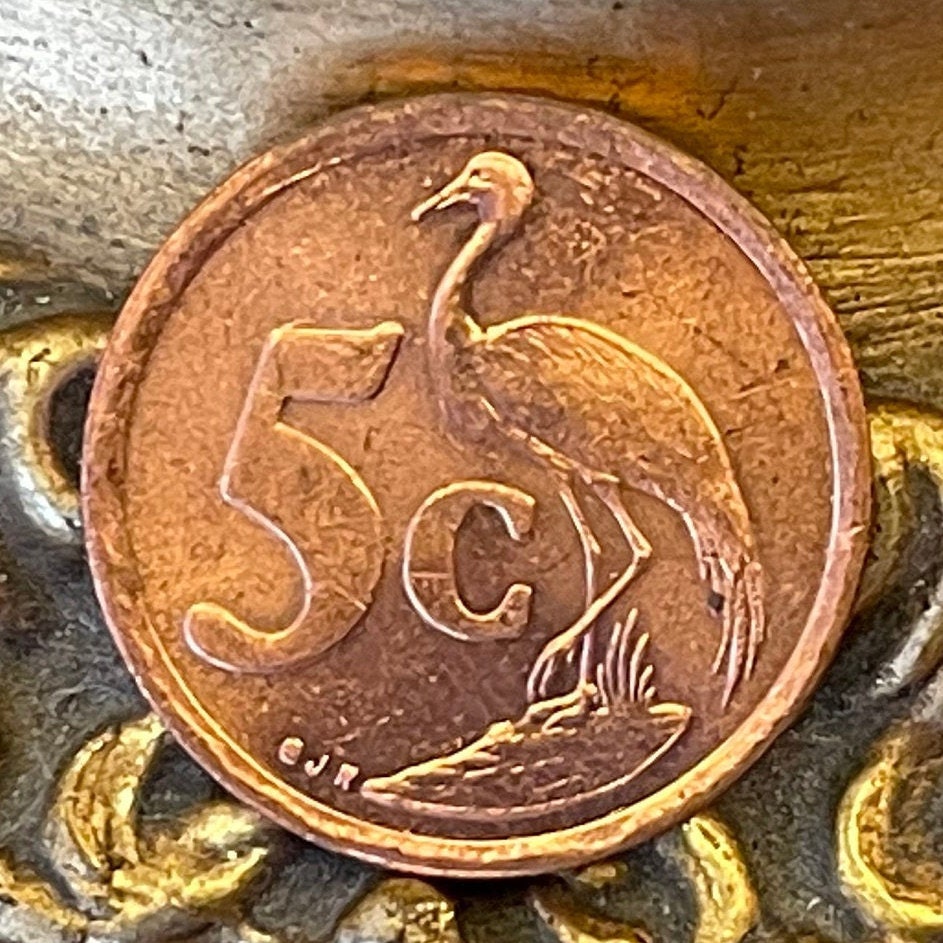elemintalshop
Paradise Crane (Copper) 5 Cents South Africa Authentic Coin Money for Jewelry (Heroism) (Blue Crane) (Power Through Unity) Resist Apartheid
Paradise Crane (Copper) 5 Cents South Africa Authentic Coin Money for Jewelry (Heroism) (Blue Crane) (Power Through Unity) Resist Apartheid
Couldn't load pickup availability
Paradise Crane 5 Cents South Africa Authentic Coin Money for Jewelry and Craft Making (Xhosa Hero) (Blue Crane) (Power Through Unity) (Resist Apartheid) (National Bird) (Men of Trouble)
Reverse: Paradise Crane (blue crane) right, value
Lettering: 5c
Obverse: South Africa coat of arms with the motto "Ex Unitate Vires" and country name in Tsonga
Lettering: AFRIKA-DZONGA
EX UNITATE VIRES
Translation: South Africa
Power through Unity
Features
Issuer South Africa
Period Republic of South Africa (1961-date)
Type Standard circulation coin
Years 1996-2000
Value 5 Cents
0.05 ZAR = USD 0.0032
Currency Rand (1961-date)
Composition Copper plated steel
Weight 4.5 g
Diameter 21.0 mm
Thickness 1.9 mm
Shape Round
Technique Milled
Orientation Medal alignment ↑↑
Number N# 3376
References KM# 160, Hern# Nc7-11, Schön# 217
Wikipedia:
The blue crane (Grus paradisea), also known as the Stanley crane and the paradise crane, is the national bird of South Africa. The species is listed as Vulnerable by the IUCN.
The blue crane is culturally significant to the Xhosa people, who call it indwe (flag). Traditionally, when a man distinguished himself in battle or otherwise, he was often decorated by a chief with blue crane feathers in a ceremony called ukundzabela. Men so honoured, who would wear the feathers sticking out of their hair, were known as men of ugaba (trouble)—the implication being that if trouble arose, they would reinstate peace and order.
It is also of significance to the Zulu people, whose kings and warriors wore a single or many feathers as a headdress.
Because of the association with warriors and heroism, the Isitwalandwe Medal was created to honour those who had "made an outstanding contribution and sacrifice to the liberation struggle", that is, those who resisted the apartheid regime in South Africa (1949–1991) in various ways. Isitwalandwe means "the one who wears the plumes of the rare bird", or blue crane.
The blue crane is a tall, ground-dwelling bird, but is fairly small by the standards of the crane family. It is 100–120 cm (3 ft 3 in–3 ft 11 in) tall, with a wingspan of 180–200 cm (5 ft 11 in–6 ft 7 in) and weighs 3.6–6.2 kg (7.9–13.7 lb). Among standard measurements, the wing chord measures 51.4–59 cm (20.2–23.2 in), the exposed culmen measures 8–10 cm (3.1–3.9 in) and the tarsus measures 20.5–25.2 cm (8.1–9.9 in). This crane is pale blue-gray in color becoming darker on the upper head, neck and nape. From the crown to the lores, the plumage is distinctly lighter, sometimes whitish. The bill is ochre to greyish, with a pink tinge. The long wingtip feathers which trail to the ground. The primaries are black to slate grey, with dark coverts and blackish on the secondaries. Unlike most cranes, it has a relatively large head and a proportionately thin neck. Juveniles are similar but slightly lighter, with tawny coloration on the head, and no long wing plumes.
*****
Wikipedia:
The coat of arms featured a shield quartered. In each quarter was a symbol of the four provinces of South Africa. An ox wagon representing Transvaal Province, a woman with an anchor representing Cape Province, two wildebeests representing Natal Province and an orange tree representing the Orange Free State Province. The crest of the arms featured a lion holding four bound sticks. The supporters were a springbok and a gemsbok. Below the arms was the Latin motto, Ex Unitate Vires (translated as "Union Is Strength" but from 1961, translated as "Unity Is Strength").
The blazon (formal description of the arms in heraldic terms) is: "Quarterly per fesse wavy First Quarter Gules a female figure representing Hope resting the dexter arm upon a rock and supporting with the sinister hand an Anchor Argent Second Quarter Or two Wildebeesten in full course at random both proper Third Quarter Or upon an island an Orange tree Vert fructed proper Fourth Quarter Vert a Trek Waggon Argent And for the Crest On a Wreath of the Colours A Lion passant guardant Gules supporting with the dexter paw four staves erect alternately Argent and Azure and branded Or And for the Supporters, On the dexter side A Spring Buck and on the sinister side An Oryx (Gemsbuck) both proper together with the motto EX UNITATE VIRES."
Replacement
Following the end of apartheid in the 1990s, the new Constitution of South Africa stated that the state coat of arms would remain the same despite the flag and national anthem changing. Nevertheless the arms were still viewed as outdated as they had been created by the white British and Afrikaner minorities without input from the black majority.[9] In 1999, the Department of Arts and Culture held a contest to design a new coat of arms. In 2000, the coat of arms was replaced on Freedom Day. Despite the replacement, the old coat of arms was still used for some official purposes after 2000, such as on some military rank insignia until 2002 and on South African passports (which were still issued with the old coat of arms on the cover) until 2007. This was attributed to the government's desire to use up old stocks of passports before issuing ones with the new design.
Share










Every coin in my order is clean and just as photographed. Coins were attached to cardboard and then shipped with extra padding. Wonderful!
5 stars review from Lizzie









